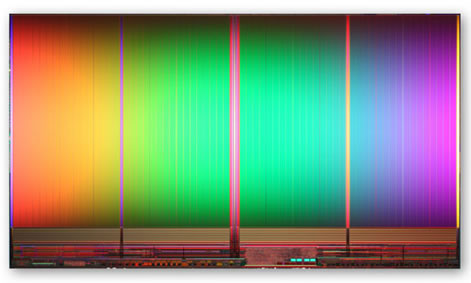Intel, Micron First to Triple Level Cell 25nm NAND
Triple level cell... what does it mean?

Intel and Micron have announced the delivery of 3-bit-per-cell (3bpc, or TLC for triple-level-cell) NAND flash memory on 25-nanometer process technology, which it claims to be the industry’s highest capacity, smallest NAND device. Traditionally, NAND stores one bit (single-level cell) or two bits (multi-level cell).
The new 64-gigabit (Gb) 3bpc on 25nm memory device offers improved cost and higher storage capacity for USB, SD (Secure Digital) flash card and other consumer electronics
The device is more than 20 percent smaller than the same capacity of Intel and Micron’s 25nm MLC, which is currently the smallest single 8GB device in production today. Small form-factor flash memory is especially important for consumer end-product flash cards given their intrinsic compact design. The die measures 131mm2 and comes in an industry-standard TSOP package.
“With January’s introduction of the industry’s smallest die size at 25nm, quickly followed by the move to 3-bit-per-cell on 25nm, we continue to gain momentum and offer customers a compelling set of leadership products,” said Tom Rampone, Intel vice president and general manager of Intel NAND Solutions Group. “Intel plans to use the design and manufacturing leadership of IMFT to deliver higher-density, cost-competitive products to our customers based on the new 8GB TLC 25nm NAND device.”
The companies have sent initial product samples to select customers. Intel and Micron expect to be in full production by the end of the year.
Stay On the Cutting Edge: Get the Tom's Hardware Newsletter
Get Tom's Hardware's best news and in-depth reviews, straight to your inbox.
-
mavroxur Very impressive. Hopefully this will lead to larger, cheaper SSD's, as well as more integrated storage in mobile devices.Reply -
irh_1974 Expect SSDs to increase in capacity in line with HDDs sooner rather than later.Reply
I want a 2Tb SSD! -
cscott_it It means that 600GB consumer SSDs are just around the corner. Take a look at some of Intel's leaked roadmaps.Reply -
SLC = ultra fast and simpleReply
MLC with 2 bits/cell = slow, with lots of disadvantages and complicated controllers.
MLC with 3 bits/cell = ???
Super large SSD drives, sure, but will they be slower than today's MLC drives ? -
willgart Relax guys... the TLC technology reduce the write speed and the endurance.Reply
I just read an article:
in 2009 Micron says: TLC is 2 times slower and 10 times less endurance. (I don't know if its compared to SLC or MLC)
-
mrecio Wow they seem to be pushing SSD tech much harder and faster then they ever did with standard hard drives. This is a good thing but probably does add to the cost some of all SSD's after all got to pay the RnD department! but yea get me a 500GB SSD for 100-150 and then ill accept it as mainstream tech.Reply
